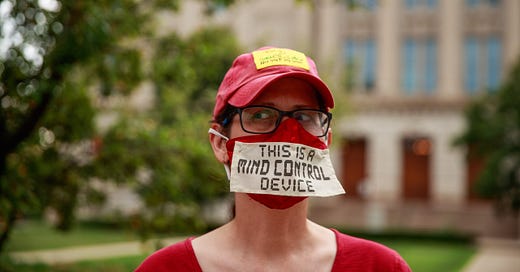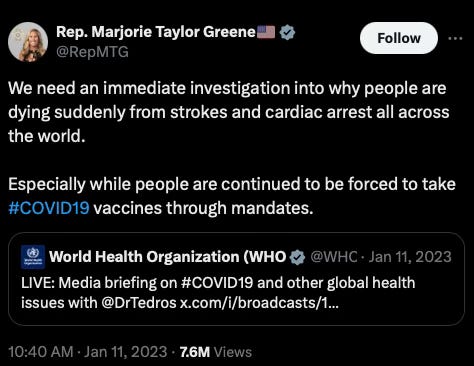
Covidiocy Marches On
Revisionism and recriminations abound as skepticism of “establishment” science becomes a tribal identity marker on the right.

Three years after the COVID-19 virus first arrived in the United States and only a few months before the Biden administration plans to formally end the public health emergency, we’re still dealing with the disease—and still squabbling over its politics.
In recent months, the so-called “liberal media” have shown a willingness to concede that some aggressive interventions launched early in the pandemic, such as school closures and some lockdowns, were excessive; some commentators, such as Brown University professor Emily Oster in the Atlantic, have suggested an “amnesty” over mistakes made in the scramble to deal with an unknown and frightening illness. The response on the right has been to do an “I told you so!” victory dance over the concessions and gleefully cry that there will be no quarter for the guilty. The idea that National Institutes of Health chief immunologist Anthony Fauci must be punished for his role in inflicting upon America a supposed totalitarian nightmare seems to have particular currency; it has even been picked up by Twitter’s new “Chief Twit,” Elon Musk, although the degree of irony he intends is hard to discern:
Meanwhile, one would look in vain for similar concessions or contrition on the right. No one is asking for forgiveness for the fine folks who confidently predicted in the spring of 2020 that COVID-19 would end up being no worse than an average flu season or that fatalities wouldn’t go up by much after the first 60 deaths by mid-March.
Or who peddled ivermectin and hydroxychloroquine (remember that?).
Or who celebrated vaccine refusers while brushing off their later deaths of COVID.
Or who contributed to the strong trend of more people in red states and counties dying of COVID-19 because of lower vaccination rates—a pattern that a September 2022 paper by three Yale scientists confirmed on the individual, Republican vs. Democrat, voter registration level. (Killing off one’s own political “tribe”: Now there’s a novel and compassionate strategy.)
Instead, the covidiot ecosystem on the right—and, to some extent, in “anti-woke” and “cultural dissident” circles that don’t always explicitly identify as right-wing—continues to flourish. Most recently, it’s been manifesting itself in the rather fanciful notion that people didn’t “suddenly” die of heart attacks and strokes before “the jab” came along.
Buffalo Bills player Damar Hamlin’s collapse of a heart attack during a January 2 football game quickly set off a storm of “it was the vax that done it” speculation, with medical luminaries like Turning Point USA’s Charlie Kirk chiming in:
Last Wednesday, Bari Weiss’s website, the Free Press, which has generally been a platform for mild skepticism toward “establishment” COVID opinion, ran a piece by skeptics-lite Dr. Vinay Prasad, a hematologist-oncologist, and Dr. John Mandrola, a cardiologist, debunking the #DiedSuddenly scare—but also asserting that the reason for the scaremongering and conspiracy theories was the supposed lack of candor on the part of medical authorities and governments. Prasad and Mandrola conclude:
People feel that their medical leaders are withholding basic facts, denying reality, disregarding new information, or worse, causing them harm. When people feel this way, they will look to other sources—even outlandish ones—that make them feel heard. Because of the continuing failures of our public health officials to discharge their duties properly, it is deeply unfortunate but also understandable that many Americans are turning to Twitter instead of the CDC.
There is not one word of criticism here for people, some of them fairly mainstream, who peddle the “outlandish” stuff. Meanwhile, Prasad and Mandrola, who believe that COVID-19 vaccines are generally efficacious and life-saving but have contraindications for some demographics such as young men—who are at low risk of serious COVID but at somewhat elevated risk of myocarditis after receiving mRNA vaccine shots, especially Moderna ones—have their own issues with “disregarding new information.” They link to their own May 2021 Stat News article as proof that “the evidence for the assertion that a Covid-19 infection is a big heart risk for young people is unconvincing.” But they forget to mention a February 2022 study published in Nature Medicine showing that, as Nature magazine summed up, “Even a mild case of COVID-19 can increase a person’s risk of cardiovascular problems for at least a year after diagnosis.” People who had recovered from COVID-19 had “substantially higher” rates of heart failure, stroke, and a number of other conditions—even people under 65 who had no risk factors such as obesity or diabetes. One could argue that Prasad and Mandrola at least performed a service in countering the vaccine panic and the associated conspiracy nonsense on a website where they were likely to be read by those wary of the “establishment.” (Along the way, they also urge caution about a recent Wall Street Journal opinion piece blaming non-COVID excess deaths during the pandemic on, as Prasad and Mandrola write, “the deadly effects of lockdown: deaths from drug overdoses, alcoholism, and homicide, as well as from diseases like diabetes and heart disease.”) But it’s very likely that, in the skeptic ecosystem, their debunkings are falling on deaf ears: Most of the comments on the article declare mistrust of any mainstream medical information and peddle outright COVID denialism, including ridiculously wrong claims that excess deaths in the European Union didn’t start going up during the pandemic until after the vaccinations began.
Once again, covidiocy (usually dressed up as “COVID dissent”) is not just the province of some radical and marginal right-wing fringe: It also implicates mainstream figures on the right. Florida Gov. Ron DeSantis, who’s nowadays being touted as kinder, gentler, saner heir to the MAGA mantle, falsely claimed earlier this month that people who get the bivalent booster shot are “more likely to get infected.” And in December, he threw a big, juicy chunk of red meat to the conspiracy theorists by asking the Florida Supreme Court to investigate “wrongdoing” related to the COVID vaccines, including supposedly false claims about their safety and efficacy. Some DeSantis fans have claimed that this is a good way to reassure the fearful by showing that rumors of vax nefariousness are baseless. To quote a famous sometime Floridian, Ernest Hemingway, “Isn’t it pretty to think so?”
The overarching theme of “COVID dissident” discourse is that “establishment” COVID policies were an insane overreaction motivated by hysteria, fearmongering and/or a hunger for power on the part of the “elites”; that the policies were imposed on a reluctant populace by means of lies and speech suppression; and finally that they did far more harm than COVID itself, as purportedly demonstrated by the countries that remained relatively free from lockdowns and mask mandates and still did just fine. Sweden, suddenly no longer a socialist hell but a blessed oasis of freedom, often gets trotted out as an example.
Sweden 🇸🇪 🇸🇪 No lockdowns 🇸🇪 No school closures 🇸🇪 No mask mandates Sweden had the lowest overall cumulative excess deaths in countries analysed by the OECD during the pandemic era from March 2020 to June 2022. pic.twitter.com/nbzI1veo8y
— James Melville (@JamesMelville) November 27, 2022
But I think we all know that trotting out carefully selected statistics is easy and that the devil is in the details. Early in the pandemic, for example—when Sweden’s laxer approach to mitigation was especially relevant—both COVID death rates and all-cause excess deaths were dramatically higher in Sweden than in other Nordic countries, which are the most appropriate benchmarks for comparison. What’s more, estimating excess deaths is not a straightforward process; much depends on the dataset and the methodology.
American discussions of the Swedish experience also typically omit some highly relevant details—for instance, that most Swedes voluntarily complied with the government’s work-from-home and social distancing recommendations even with no formal restrictions. In other words, the Swedish experiment was not about simply “protecting the vulnerable” while everyone else lives a normal life and acquires “natural immunity” to the COVID-19 virus by contracting the disease—the fantasy touted by the “dissidents” in the United States and often associated with the so-called “Great Barrington Declaration.” (Two of the declaration’s three authors, Jay Bhattacharya of Stanford University Medical School and Martin Kulldorff, formerly of Harvard Medical School, are central figures in the “dissident” community and also figure prominently as victims of alleged censorship in the “Twitter Files.”)
Were there actual “overreactions” or excessive mitigation measures? Vox science correspondent Kelsey Piper, who has been willing to challenge conventional wisdom on COVID-19, told me by email that one could make a case for either overreaction or underreaction, depending on the specifics: “It still seems insane to me that in January and February 2020, people saying this is a big deal were scolded and people preparing were mocked—at that time, we didn't know all that much about how lethal and how contagious the virus was. I think at that stage the correct response is one that will look like an overreaction in hindsight, because you want to prepare for worse news than your median estimate.” Piper does believe the March 2020 lockdowns that were extended far beyond the initial plan of two weeks “included a bunch of policies that were definitely overreactions,” above all “closing outdoor spaces.” She shares the increasingly widespread view that school closures were unwarranted and went on too long (though qualifying it by pointing out that in the first year, “a lot of demand for online school was on the parent side”) and agrees with many of the criticisms of how the reopening was handled (“The people who are bitter that churches were often closed longer than bars are completely justified in their bitterness, that was pretty inexcusable”). Piper sums up:
So we underreacted in January and February, reacted strongly but maybe appropriately so in March, and then were by April onwards clinging to the March measures without a sense of which of them were worth it long term and which had only been worth it to buy time, and then by year 2 we had some absurdly unnecessary measures still in place. And we were still underreacting in other respects, like not treating research into pandemic prevention as a priority. Is that overall overreacting or underreacting? I don’t think you can do better by just pushing "react less" or “react more.” . . . The reaction has to not be stupid, it has to be responsive to the actual facts on the ground, and it has to be possible to change when the situation changes, and all of that matters more than how objectively large it is.
Yale University professor Nicholas Christakis, a social scientist and epidemiologist whose 2020 book, Apollo’s Arrow, looks at the impact of the coronavirus—and who co-wrote with his wife, educator Erika Christakis, an early article on alternatives to COVID-related school closures—has even less patience for the “overreaction” narrative. In a phone interview last month, Christakis was emphatic on the subject:
Even the idea that there was a hysteria, when a new leading killer was introduced—COVID was until recently one of the top three killers in our society, it’s lopped off 20 years of progress in life expectancy, it’s a new infectious disease, over 1.1 million [Americans] have died already despite vaccination—the idea that people were, quote, “being hysterical about it” is absurd, just absurd. It doesn’t mean that there weren’t mistakes—but the idea that we should have somehow simply protected the elderly in some kind of magical way unspecified and let everyone else live a normal life, this was not easily achievable and people typically don’t explain how we would have done that.
To be fair, the Great Barrington Declaration did have proposals, just not workable ones (such as massive relocation of older and vulnerable people, sometimes to temporary housing in empty hotels). The risk groups, of course, include not only the elderly but middle-aged and even younger people with a wide range of health conditions. What’s more, the “dissidents’” almost exclusive focus on deaths as a measure of the disease’s impact and danger misses other effects—not only damage from severe illness (aside from the debate about how common “long COVID” really is) and the increased risk of heart attack and stroke after even mild infection, but the effect of death and severe illness on family members, relatives, and even close friends. Increases in drug abuse and suicide are frequently blamed on lockdowns and the distress they caused, but such arguments generally ignore the distress caused by the deaths from COVID of loved ones, including parents. Imagine the impact, human and economic, if reduced mitigation measures had meant twice as many deaths, or even 50 percent more deaths.
Speaking of economic impact, the notion that pandemic-era economic ravages were caused by lockdowns and not by the disease itself is also unsupported by evidence, in the United States and elsewhere. A study published last August by researchers at the Institute of Global Health at Michigan State University in East Lansing found that “there was no trade-off between public health policy and economy during the COVID-19 pandemic in the Nordic region”: While Norway did have a greater increase in unemployment by the start of 2021, gross domestic product trends were the same for all of the region’s countries, and “Sweden’s relaxed and delayed COVID-19 health policy response did not benefit the economy in the short term, while leading to disproportionate COVID-19 hospitalizations and mortality.” Closer to home, nearly a third of businesses in “free” Florida (32.2 percent) were closed in April 2021, just a few percentage points below “locked-down” California (35.9 percent) and New York (35.4 percent) and significantly above “locked-down” Minnesota (26.6 percent).
Looking back at pandemic management, Christakis believes that one problem from the start was the failure to “educate the public on the fluidity of science”: “When scientists change their mind because of new evidence, that’s a feature, not a bug; that’s what they’re supposed to do. But I think the American public took [it as] flip-flopping.” That’s a good point, but it’s not easy to pursue a reasonable communication strategy when there is a concerted effort to demonize scientists, more often than not by means of distortions and lies.
Once again, that extends to some mainstream outlets. Last August, for instance, Tablet, the generally centrist Jewish magazine that in recent years has sometimes platformed fringe far-right voices, ran a piece by San Francisco attorney Michael Senger titled “Deborah Birx’s Guide to Destroying America,” the gist of which was that Birx, the White House COVID response coordinator under Donald Trump, played a leading role in subjecting America to Chinese-style totalitarian lockdowns. Reviewing Birx’s COVID memoir Silent Invasion, Senger makes the shocking assertion that Birx’s reaction to COVID was influenced by trauma caused by videos of suffering, dying, and dead COVID patients that were actually “were exposed as fake by the Associated Press and other outlets in February of 2020.” But the AP article linked by Senger is very obviously talking about a different video than the one described by Birx. Their debunking targeted a video that supposedly showed dead bodies lying on the ground, but actually showed people sleeping in the street; Birx was describing a video showing scenes from a hospital, including two dead bodies covered with plastic. As for the other link, it leads to the far-right conspiracy site Revolver News.
While the “dissidents” demonize Birx and Fauci, the Great Barrington Declaration’s Bhattacharya (who was, on January 25, the inaugural guest on the Free Press Forum Zoom discussion program on Weiss’s Free Press site) is given a pass on his repeated—and repeatedly documented—underestimations of the pandemic’s death toll. As David Wallace-Wells noted recently in the New York Times, Bhattacharya wrote in an Indian publication in January 2021 that a mass vaccination campaign in that country would be not only unnecessary but harmful since the majority had already acquired natural immunity from infection. That was before the Delta wave hit; it killed half a million to five million people. In June 2021, Bhattacharya and Kulldorff wrote that the pandemic was “on its way out” in the United States; more than half a million people have died since then.
Has there been coronavirus “hysteria” and excess on “the other side”? Sure. I’ve noted before that some accusations of COVID-related wrongdoing or negligence against the Trump administration turned out to be mostly false or exaggerated and that political polarization caused some progressives to circle the wagons around school closures. There was some COVID “fear porn,” such as a March 18, 2020 New York magazine piece telling the fictitious story of a young man who suspects this whole COVID thing may be overblown, gets a little careless about social distancing, and then gets the disease and dies after prolonged agony. (The ostensible purpose was to chronicle what the virus can do to a human body, but the moralizing was unmistakable.) Now, almost three years later, there are activists on the left who deplore the relaxation of pandemic restrictions (such as masking mandates) at a time when most experts believe the restrictions are no longer necessary. When New Yorker writer Emma Green published a critical piece about one such group, she was nastily attacked on Twitter, and the Nation skewered her for “reactionary centrism.”
But generally speaking, left-wing covidiots who think we should act as if it were still March 2020 are not treated as mainstream opinion makers in left-of-center discourse. Right-wing covidiots who think the real problem in March 2020 was Anthony Fauci and that the real problem today is “the vax” are much more firmly ensconced within the right and in “anti-establishment” circles. In December, the Free Press even touted hardcore antivax crank Alex Berenson as a victim of Twitter censorship while describing him simply as “a journalist skeptical of lockdowns and mRNA vaccines” with “hundreds of thousands of followers.” Ten days earlier, Berenson had treated those hundreds of thousands of followers to a thread that harassed the widow of soccer analyst Grant Wahl by speculating that Wahl’s sudden death at the World Cup was due to “the jab.” Wahl’s widow, Dr. Céline Gounder, is a professor at New York University’s Grossman School of Medicine and a strong vaccine proponent who served as a COVID-19 adviser on President Joseph Biden’s transition team. (A statement by Gounder made clear that Wahl’s death was entirely unrelated to his vaccination.)
The irony is that, if what COVID-19 “dissenters” hate most is the pandemic’s disruptions to daily life and restrictions on our freedom, “the jab”—which offers only weak protection against infection with COVID’s newest variants but still provides substantial protection from severe disease—is the best option. For all that we hear about how COVID is no longer a “pandemic of the unvaccinated,” unvaccinated people are still dying of COVID at something like 5 times the rates of the fully vaccinated and more than 10 times the rate of those who have also received the new bivalent booster (at present, that’s only around 13 percent of the population). You’d think smart advocates of post-pandemic normalization would urge people to get the new booster. Instead, to take a recent example, the Wall Street Journal has run a piece decrying the bivalent booster campaign on the grounds that we supposedly don’t know if the evidence for the booster’s efficacy conflates its effect with that of other factors (which is not very likely).
I don’t think vax skeptics want people to die any more than vax proponents want to impose tyranny. It’s just that right now, skepticism of “establishment” or “mainstream” science on COVID-19 has become a tribal identity marker for a lot of people on the right (and for some “anti-woke” centrists). They have prominent politicians in their camp, as well as the new head of Twitter. And that’s bad news for our ability not only to further improve our response to a virus that is still killing Americans but to respond to future public health emergencies. Whatever mistakes members of the medical “establishment” may have made, the blame rests overwhelmingly with those who have exploited fear and mistrust for political purposes.













